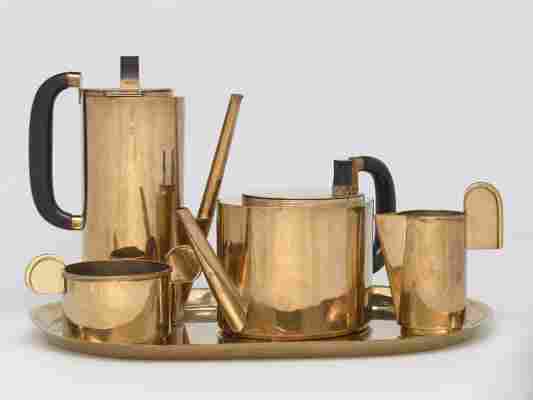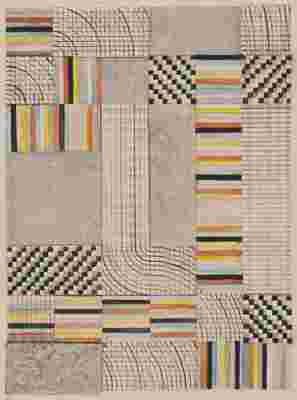September 16,2022
The Bauhaus’s Untold Impact on Everyday Design in America
by David Stewart
This year marks the 100th anniversary of the founding of the Bauhaus design school in Weimar, Germany, and tributes are being held globally. In Cambridge, Massachusetts, the Harvard Art Museums will display nearly 200 works by 74 artists in a new exhibit, "The Bauhaus and Harvard." Almost all come from Harvard's Busch-Reisinger Museum, which houses the largest collection of Bauhaus artifacts outside of Germany.

Herbert Bayer, Verdure , 1950. Oil on canvas. Harvard Art Museums/Busch-Reisinger Museum, Commissioned by Harvard Corporation, 1950.169.
Founded by architect Walter Gropius, the Bauhaus was hugely influential on art and design in the 20th century, and remains so today. The school's pioneering approach to teaching combined instruction in crafts and the fine arts—a radical notion at the time. Alongside the dawning of a new industrial age, the Bauhaus focused on the intersection of craftsmanship and mass production and art and technology in fields as diverse as weaving, metalworking, furniture design, and architecture. The result revolutionized how ordinary people experienced everyday life through the objects they touched, used, and relied on. If you've ever admired a teapot from Target or appreciated the elegance of an iPhone, you already inherently understand the Bauhaus's impact.

Wilhelm Wagenfeld, Coffee and Tea Service: 5-Piece Set ,1924–25. Brass with mercury silvered interiors and ebony fixtures. Harvard Art Museums/Busch-Reisinger Museum, Gift of Hanna Lindemann.
“That's influenced almost all arts education today,” says Laura Muir, research curator in the Division of Academic and Public Programs at Harvard Art Museums, which opens February 8. The exhibition tells the story of the Bauhaus itself, from its founding in 1919 to its postwar spread through the United States, with special emphasis on its pedagogy. Divided into three thematic sections, it explores objects made at the Bauhaus in Germany, the influence of Bauhaus teaching in America, and Walter Gropius’s archive. (A complementary exhibition features Hans Arp’s restored Constellations II , a sculptural relief commissioned for Harvard's Graduate Center; also, a comprehensive archive of the museums’ 32,000 Bauhaus-related objects can be browsed online.)

Anni Albers, Design for a Rug , 1927. Black ink and watercolor over graphite with drawn and cut paper additions on off-white wove paper. Harvard Art Museums/Busch-Reisinger Museum, Gift of Anni Albers.
While the requisite tubular steel frame chairs and silver tea services are here, the spotlight is more prominently focused on rarely seen student exercises, photography, textiles, typography, paintings, and other archival materials. “It's a very particular view of the Bauhaus,” says Muir. “It's not just the iconic objects we know today.”
As a subtheme, Muir also strives to highlight the gender inclusivity that the Bauhaus practiced, in a time when such things weren't exactly de rigueur. “Women were very present,” explains Muir, who underscores the work of photographer Lucia Moholy and textile artists Anni Albers, Gunta Stölzl, and Otti Berger (who tragically died at Auschwitz), among others.
Lucia Moholy, Bauhaus Building, Dessau, Germany ,1926. Gelatin silver print. Harvard Art Museums/Busch-Reisinger Museum, Gift of Ise Gropius.
Gropius himself is largely to credit for the large collection that Harvard holds. Having emigrated to the United States from Nazi Germany by way of England, he chaired the Graduate School of Design's Department of Architecture from 1937 until 1952. In the late '40s, alongside curator Charles Kuhn, he began to assemble an archive by requesting donations from Bauhaus colleagues, teachers, and artists who had also come to the U.S., including Anni and Josef Albers, Lyonel Feininger, and László Moholy-Nagy. The idea, says Muir, was to assemble “a study collection that future students would really use and work with.”
Kuhn, who was curator of what was then called the Germanic Museum at Harvard (now the Busch-Reisinger), had worked for an Allied armies program during the war to find and restitute looted artwork in Europe. Understandably, he was among few people in America at the time interested in collecting—or in any way celebrating—German art and achievement. In retrospect, says Muir, “preserving Bauhaus objects was kind of a genius idea.”






